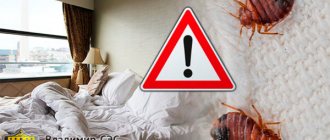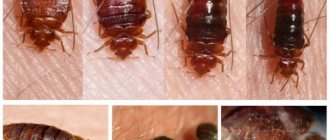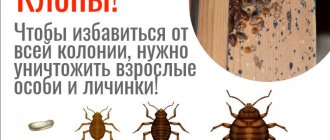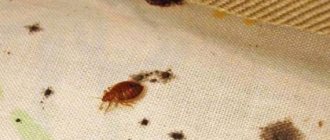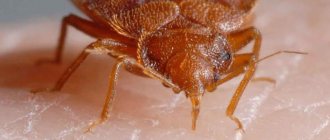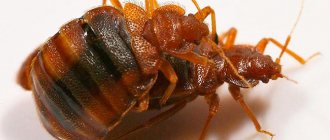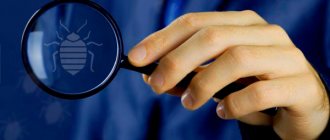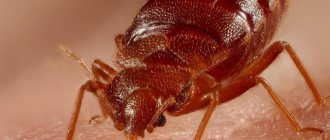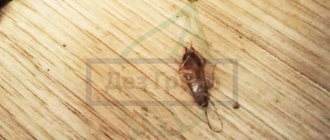At what temperature do bedbug eggs die?
Changing environmental conditions negatively affects the condition of parasites.
They reproduce less actively. With slight fluctuations in temperature, the lifestyle of parasites does not change, especially if access to a food source is open. Bed bugs are affected by significant increases or decreases in temperature.
Critical temperature below zero
Insects at various stages of development, including those inside protective shells, die instantly if exposed to a temperature of at least -30°C. When environmental conditions change less significantly - to -7°C below zero, the parasites in the eggs will die after 1.5 months.
Critical temperature above zero
The death of insects occurs at temperatures from +55°C and above. In such conditions, parasites die immediately. If the temperature is maintained at +45...+50°C, the death of bedbugs occurs within 24 hours.
The critical temperature for bedbug eggs is +45°C or higher
How to find out if there are bedbugs in your house
There are several signs that suggest the presence of bedbugs in an apartment:
- bites on the body after sleep;
- traces of droppings on the sheets in the form of black dots;
- blood stains if a well-fed insect was accidentally crushed during sleep.
Finding black traces of excrement on the sheets and mattress is one of the first signs of bedbugs in the house.
It is not difficult to identify bedbugs. Most often they prefer bedrooms. Having found a nest, you will see the entire bedbug family there: brown adults, larvae of different sizes, painted in light colors, as well as a large number of small white eggs.
What do bedbugs look like at different stages of development?
During its life, one bug goes through an incomplete stage of transformation. Small white eggs 1–1.5 mm long hatch into nymphs - small copies of adult insects no more than 1.5 mm long. They differ from the adult parasite in their tiny size, light color and translucent body.
The full development cycle of bedbugs from egg to adult takes from one to three months
The nymph's development process takes 5 weeks, and during this time it molts exactly 5 times. Like adults, nymphs feed on blood, but their bodies are painted scarlet. With each molt they increase in size and darken.
In the bedbug you can see the whole family: nymphs at all stages of development and adults after a hearty meal, as well as white eggs with unhatched parasites
How to identify bedbug nests
After bites appear or droppings are found on the bed, do the following:
- Carefully inspect your sleeping area.
- Lift the mattress and look under it - there should be no black spots from droppings and, of course, bedbugs themselves.
- Examine the seams of the mattress.
- If there is wallpaper in the room, then inspect the places where it lags behind the walls.
- Look under the linoleum where you can do this.
- Inspect the cracks in the corners of the baseboards. To do this, you can use a flashlight.
- Examine outlets and switches. It is best to do this in the early morning, when bedbugs are most active. You can often see black droppings.
- Inspect the upholstered furniture from the inside. Bedbug nests are often found at the joints between upholstery and wooden bases.
- Look under the furniture. You can use a regular broom and sweep the floor. If there are bedbugs in your house, you will probably find them in the dust.
- Move aside cabinets and chests of drawers. Inspect the backs of the furniture and the walls themselves.
- Lift the rugs off the floor and examine the underside.
- Take a good sniff during the inspection. Bed bugs emit a sweetish smell of cognac, so in places where they accumulate you will feel this characteristic aroma.
Bed bugs are most difficult to identify in their early stages. If they have managed to multiply and thoroughly settle in the apartment, finding them will not be difficult.
In the bedbugs you can see individuals at all stages of development
This knowledge will be useful if you are going to rent housing from the owners or buy an apartment that was previously inhabited by other people. It also doesn't hurt to chat with your neighbors. If bedbugs have ever lived in their apartments, then it is likely that the parasites could move into your home.
Photo gallery: favorite places of bedbugs
In cases of severe infestation, bedbugs can also appear in the carpet pile
At the junctions of the upholstered part of the sofa and its wooden structure, you can often find a bedbug nest
Around the outlet where bedbugs have infested, you can often notice traces of droppings
Bedbugs often get inside the mattress
In advanced cases, in places where wallpaper is peeling off and near ceiling skirting boards, whole hordes of bedbugs can be seen with the naked eye.
Parasites often hide under the folds of the outer seams of the mattress
Offspring
Despite the fact that bedbug eggs are very small (about 1 mm), and they themselves are difficult to notice, the female lays them in secluded places and carefully hides them. After a few days, a larva appears or, as entomologists call it, a nymph. To understand what bedbug larvae look like, just look at an adult. A nymph is an exact copy of her, only smaller in size.
The larva grows very quickly. With plenty of nutrition and comfortable temperature conditions, it reaches its adult state within a month. During development, the larva molts several times (sheds its chitinous shell).
Interesting! Nymphs cause particular discomfort to humans. They do not know how to inject an anesthetic substance into the bite site, so during feeding it is their bites that people feel at night.
What does a bedbug bite look like?
In addition to all this, the presence of bedbugs can be determined by the condition of the bite site. Although each person has an individual reaction to insect bites, there are still features characteristic only of a bug:
- They leave behind trails consisting of 3-5 bites, located at a distance of 2-3 cm from each other.
- Since these are collective insects, many such paths appear during the night.
- Upon careful examination of the injury site, a trace of a puncture through which blood was sucked is noticeable.
Bedbugs are active at night, so after sleep, burning and itching of the damaged surface appears. The main thing they bother a person with is their bites, which are very painful, and the resulting wound can subsequently itch for a long time. In addition, sensitive people may develop allergies. To avoid such troubles, you should always carefully inspect the premises of hotel rooms or rented apartments.
You can find a bedbug if you know what it looks like and where it might be hiding. An important factor in the appearance of bedbugs is the condition of the host’s skin; healthy skin attracts bedbugs.
To make sure whether there are bedbugs in the room, just carefully inspect such places and everything will become clear.
More often you can see not bedbugs, but chitinous shells remaining after their molting is complete. Whole clusters of dry skins may be found. This is direct evidence of the presence of bedbugs.
Their presence is revealed by brown spots on the bed linen.
During the day, you can see insect excrement, similar to poppy seeds - small, looking like dark dots.
What to do if bedbugs are found during inspection
You must first find the pest nests. This will get rid of most of the insects. In this case, parasites are destroyed mechanically or with chemicals (by acting on the nests). At the next stage, they move on to getting rid of stains and odors, since the excrement of parasites has managed to penetrate into the structure of the upholstery of upholstered furniture. Then choose any of the methods for treating things in the territory of the contaminated house and the premises itself:
- temperature exposure (steaming, boiling, washing at high temperatures, ironing, freezing);
- insecticides;
- folk remedies for bedbugs.
To remove parasites, it is recommended to use several methods at once. For example, folk remedies are used at the last stage, when the room is cleaned. They are used to prevent re-infection of the apartment.
It is recommended to remove bedbugs using insecticides. Individual items are cleaned by exposure to temperature.
Lifestyle
Bedbug Habitat Despite the fact that the bedbug does not have wings and cannot fly, it moves easily, climbing onto the ceiling and walls, after which it glides safely. Insects are nocturnal, and during the day the habitat of bedbugs is:
- bed;
- mattress;
- sofa;
- other pieces of furniture;
- books;
- cracks;
- cloth;
- Appliances.
They like to hang out where it is dry and warm. They can live not only in dirty apartments, but also in rooms that are always kept clean. But when bedbugs are active, it is between three o’clock in the morning and eight in the morning. If they are very hungry, they may well attack a person under artificial light.
Even in an empty apartment, bedbugs live for about a year. If the room temperature is low or the bloodsuckers are hungry, they can enter a state resembling suspended animation. Bed bugs migrate quietly if living conditions are not suitable for them. In one minute, an adult can crawl about 1.25 m, and a larva - about 25 cm. In 10-15 minutes, they can drink blood in an amount twice their weight.
The parasites are very tenacious and can withstand temperatures up to + 49°C. If there are pets in the house, they can become prey for bed bugs. They mainly like to bite children and women. Insects have a very thin proboscis with two channels. One day after immersing itself in the skin, the parasite introduces an enzyme, thanks to which the person does not experience pain and does not feel how the bug bites. Through the second, it sucks blood. Nymphs are more voracious, unlike large bugs. Their bites are painful, since the saliva has not yet developed a component that can relieve pain.
The insect's larval period takes a month. During the remaining time, the female lays 4-5 eggs daily. On the fifth day, a nymph appears; after a month, she becomes an adult, ready for reproduction. The bedbug feeds once every 5-10 days.
The question of what bedbugs are for also often arises among people. In ancient times, they were credited with healing properties - supposedly bedbugs could neutralize snake venom. This has not been scientifically proven. But the fact that they are eaten by cockroaches, flies, spiders, centipedes, and ticks is a proven fact.
Bed bug sizes
Millions of years of evolution have made the bed bug an ideal ectoparasite. The miniature size and flat body of a hungry insect makes it invulnerable to mechanical stress, and the ability to develop immunity to various types of insecticides increasingly complicates the process of fighting bloodsuckers. According to entomologists, in the near future humanity will face massive “bedbug epidemics” around the world.
Depending on the stage of insect development, the body length can vary greatly and have the following values:
- ripening eggs - no more than 1 mm;
- first stage larva – 1.5 mm;
- second stage larva - 2 mm;
- third stage larva – 2.5 mm;
- fourth stage larva - 3 mm;
- fifth stage larva – 4.5 mm;
- adult insect – up to 5.5 mm.
Nymphs hatched from eggs are an exact copy of an adult insect, the only difference is that they are not able to reproduce and are almost white in color, while mature individuals are brown. From the first days of life, nymphs thirst for human blood, because without it they will not be able to change their chitinous cover and move on to the next stage of development.
The size of a domestic bug (aka bed bug) is greatly influenced by the degree to which the insect is saturated with human blood. While eating, the body of the sucked parasite can lengthen by 2 times, while the insect becomes slow and clumsy, and the body takes on a rounded shape.
Bed bugs, despite their body size and age, will equally cause painful itching and allergic reactions in a person with their bites, not to mention mental disorders. Therefore, if you find blood-sucking insects in your apartment, you should take immediate action, because the health of you and your family is at stake!
House bugs
The most unpleasant and unwanted insect that can appear in any home, regardless of the wealth and cleanliness of the household. In principle, a bed bug is a linen bug. It received this name because of its behavior and habitation. Since it prefers to hide in the folds of furniture, bedding and live in beds, closer to the power source.
There are several dozen existing types of house bugs. They are all similar in structure and behavior. But the type of bed bug can be distinguished by several characteristics. The body is flat, small, capable of increasing its size several times. The wings atrophied as unnecessary. Parasitic insects enter other apartments by “traveling” in furniture and suitcases.
In places where bedbugs accumulate there are a lot of remains of their vital activity: skins of chitinous shells, scales, excrement, egg shells, droplets of blood and simply dead bedbugs.
Different types of bedbugs in an apartment cause the same damage to the inhabitants of the home. Besides the fact that they feed on human blood and do not make concessions to anyone, it is a big misconception that bedbugs “love” someone more. It's just that different people react differently to bites. Some people get severe itching and crimson spots that swell and swell, while others may not even immediately notice small punctures on the skin.
The bed bug's closest relative is the stinging bug. Minor differences in the behavior of the insect allowed scientists to classify it as a separate species. It is slower and can jump when moving, apparently compensating for its low speed. Cold is destructive for it, so it can only be found in countries with a hot climate. When changing from southern to northern latitude, it quickly dies.
It bites more painfully, which is why it is hot. The person gets an allergic reaction, like hives. The itching is unbearable, which forces you to scratch the bite sites, further injuring the skin.
Perhaps the most dangerous type of bedbugs lives in Latin America. This is an insect from the family of predators. Its bite is dangerous due to the developing allergic reaction that threatens anaphylactic shock.
The triatomine bug bites humans mainly at night, when the “victim” is sleeping. The insect's saliva may contain an infection called Chagas disease, which is caused by protozoa. This disease is fatal, for which there is still no cure.
The world of insects is much more interesting than it might seem. The number of some species reaches hundreds and amazes with their ability to adapt to the surrounding world.
Even bugs are represented by so many insects that are divided into large groups, some of which are capable of helping humans, preserving and increasing crops, and conducting “invisible” pest control in the garden and in greenhouses. Others simply lead a parasitic lifestyle, not only feeding on human blood, but also damaging furniture, mattresses and sofas.
The ability to use modern methods and chemicals to combat parasites greatly simplifies human life. Using other bugs as biological weapons against pests is a new modern approach to growing crops.
Size of house bugs
Wounds of unknown origin were found on the body.
At night you wake up from itching, and in the morning there are strange brown spots on the sheets.
Our article will tell you how to determine what kind of parasites are in your home based on their size, color and other characteristic features.
Habitats in the apartment
Due to their small size, it is difficult to determine that there are pests in the house.
If there are bites on the body and brown spots on the bed, then most likely these are bedbugs.
Bloodsuckers are called linen, bed or house bugs.
Fact! 70% of people do not notice bedbug bites.
You should check your favorite habitats:
- bed and mattress,
- cracks in the floor,
- back of the closet, sofa,
- under the baseboards,
- at the joints of wallpaper in places where they have peeled off,
- under the carpet.
Advice! Look carefully at the folds on the sofa and curtains. Inspect the seams in your mattress and travel bags.
Bed bug eggs
The shape of a grain of rice is oblong and slightly curved. The color is whitish translucent. The size is 1 millimeter.
The rate of reproduction of parasites is enormous. The female lays up to 5 eggs per day (some sources indicate up to 15). During life, the number is about 250 pieces.
Incubation period
At 35 0 C, bedbug eggs mature in 4-7 days after laying. At 15-27 0 C – for 1 month.
In case of unfavorable conditions with temperatures below +10 or above +45, the embryos mature within 3 months.
The egg shell protects the larvae from temperature changes, mechanical stress, and pesticides.
Advice: to destroy eggs and adults, use long-acting (several months) insecticides.
Stages of development
The egg hatches into a larva that needs food to develop. The maturation period is 6 weeks. This is a miniature copy of an adult insect.
The larvae grow by shedding their shells. Molting requires human blood. They feed every 5-10 days. If necessary, suck the blood of domestic animals, birds, rats, mice. They attack at night.
There is no nest, but parasites accumulate in one or more hard-to-reach places. Eggs, larvae and adults live in colonies, shedding empty skins and depositing excrement.
Weekly chart of bloodsucker development.
Interesting! When the bug gets enough, the abdomen stretches. The insect becomes inactive, and therefore more vulnerable to mechanical influences.
An adult parasite drinks up to 7 mg of blood at a time (twice its own weight), and the larva drinks less than 1 mg.
Size
The color, size and shape of the body depends on blood saturation. A mature individual measures 0.3 to 0.84 centimeters in size. Males are smaller than females by 0.2 mm. The color changes from dirty yellow to dark brown. The larvae are lighter. The shell of a hungry insect is light translucent. A bloodsucker that has eaten is purple or scarlet, with a rounded abdomen. The body length is twice that of a hungry parasite. Bedbugs that fed about 2 days ago are dark brown in color.
Differences from other insects
House bugs belong to the order Hemiptera.
Parasites can be identified by their appearance characteristics:
- Lack of wings;
- The body is wide and round for those who are well-fed, and flat for those who are hungry;
- A constriction in the abdomen indicates that it is a wasp or an ant;
- Bed bugs bite only exposed areas of the body, while lice live in the hair and are very mobile;
- A bug has 6 limbs, a tick has 8.
Fact. It is possible that bedbugs can infect humans with tularemia, brucellosis, smallpox, hepatitis B, tuberculosis, typhoid fever and anthrax.
Pest bites cause allergies and skin rashes. Characteristic symptoms of wounds are accumulation in one place with an interval of 2-3 cm.
How to get rid
- independently (disinfestation and traditional methods)
- call professionals.
Independent methods of struggle include:
- temperature treatment (freezing and steam),
- destruction by chemicals,
- repellers,
- folk remedies (herbs with a strong pungent odor - tansy, etc.).
Disinsection is carried out by special services that guarantee their work for up to 6 months.
Note! Magnetic resonance and ultrasonic repellers get rid of cockroaches and basement fleas. Not effective against bedbugs.
Conclusion
Bedbugs hide during the day and hunt at night. Due to their miniature size, it is difficult to detect and distinguish from other insects.
Armed with the information in this article, you will determine what kind of insects are in your apartment and get rid of them forever.
Folk remedies
A reliable way is to get rid of pests using high temperature. It is necessary to treat bedbug nests using a steam generator. An ordinary household hair dryer will not work - it will not be able to maintain a high temperature for a long time. Insect nests and possible places of their stay are processed.
Folk recipes suggest using products with a pungent odor, for example, kerosene, vinegar, turpentine. When diluted, these substances are used to lubricate baseboards, bed legs, and furniture parts. But the pungent smell will be unpleasant for humans and pets, and they will have to leave the apartment for a while.
You can use aromatic oils and herbs with a more pleasant aroma for humans. Essential oils of tea tree, eucalyptus, and orange are not liked by bedbugs. Among the plants they do not like tansy and wormwood. But it should be remembered that parasites do not die from odors, but only leave the room. There is a risk that they will return after some time.
Why are bedbugs dangerous?
First of all, there is a high risk of developing allergies. Linen bug bites do not contribute to the infection of humans with dangerous diseases. It is known that insects of this species carry pathogens, but when attacking a person, bacteria and viruses are not transmitted, because they enter the digestive tract. From there they have no way back to the salivary ducts.
As parasites live in a person’s home, they leave a large amount of excrement, shell husks, and empty egg shells. There is an unpleasant smell at home. The reason for this state of the apartment is that insects multiply rapidly. The room may become completely infested after a few months. Moreover, the parasites themselves will be cramped; some individuals may go in search of a new home.
Bed bugs nest
Features of the structure of domestic bugs
To answer the question of what bedbugs eat, you need to study the structure of their body. House bugs have piercing-sucking mouthparts, which means that the parasites mainly feed on liquid food. The arthropod has a modified lower lip, which has the shape of an oblong, sharp tube. The sharpness and strength of this tube is quite enough for bedbugs to pierce the skin of a person or plant.
In order to start feeding, bedbugs choose a victim and a place to bite, after which the insect places its proboscis on the skin, rotates its head, while the oral tube bends slightly and a small needle emerges from it, which pierces the victim. After the body is pierced, the proboscis immediately enters and the nutritional process begins to occur.
Since bedbugs are small parasites, they only bite the victim where there is no hair. That is, these parasites will definitely not bite in the head and groin area. If a person sleeps in underwear, then bedbugs are unlikely to crawl under it; their task is to find exposed parts of the body.
The peculiarity of the body structure of bedbugs is that when the insect is hungry, its body has a flat figure, and after the parasite is filled with blood, the body begins to swell and the bug increases in size, while the color of its body also changes to a more distinct shade of gray.
The digestive system of bedbugs consists of two channels, food enters the first, and it is digested in the second. Blood-sucking insects produce a special anesthetic enzyme that is injected into the victim. Accordingly, the victim does not feel anything during the bite and continues to sleep.
Parasites do not feed only at one time, they first consume about 1-1.5 µl of food, and then make a second visit. This can last up to 7 times. This is why victims often experience a red carpet of bedbug bites.
It is important to remember how often bedbugs feed, because they do not do it regularly and therefore about a week should pass after the first meal. Only then does the parasite re-enter
What do bedbugs eat?
The question arises, how do bedbugs survive without human blood if the owners of the apartment have moved out for a long time. It seemed that the simplest explanation was that bedbugs begin to eat everything, for example: wallpaper paste, fur, dust, other insects, and so on. But all this is not true, since bedbugs feed exclusively on blood.
If the victim is absent for several days or months, the parasites may not even notice it. And if a person has been gone for a longer period of time, then amazing self-preservation reactions begin to occur in their body. This is how bedbugs stop reproducing, moving, growing and generally functioning. They turn into dry little bags, but as soon as food appears again, these parasites begin to live actively again and try to completely restore their supply during the absence of humans. Therefore, exterminating bedbugs in Moscow by leaving the apartment for a while is a very bad option and in the end will not give any results, because the answer to the question of what bedbugs eat if there are no people is quite simple - nothing.
What do bed bugs eat in the wild?
As you know, not all bed bugs live near a person in an apartment; some can simply live in the wild. The question arises, what do bed bugs eat in the wild? Even with such a rare phenomenon as life, far from humans, bedbugs still continue to feed on blood. Any mammals become victims. Often bed bugs can be found in caves where the same temperature is maintained; in these places the parasites feed on the blood of a bat. The choice of these victims is that in bats there is no hair under the wings, and the bugs have easy access to blood vessels.
How to detect bedbugs in a bed
If the bed is iron, of an outdated model, then parasites do not live on such a structure. They prefer wood or textiles. On a wooden structure, insects usually settle inside: under the mattress, on the side walls, in the corners. You may also see red dots on the bedding or mattress. They are clearly visible on light-colored underwear. If the cover on the pillow is damaged, insects can get inside. However, pests rarely establish themselves here, for example, in cases of severe infestation, where little attention is paid to cleaning and changing bed linen.
There is a colony of bed bugs in hidden places of the bed.
How to destroy an individual while the size of the bedbug is small
The methods for controlling larvae are the same as for killing adults. In order to eliminate the problem of infestation in an apartment as quickly as possible, you should treat bed bugs with different means, and it is advisable to use them simultaneously
It is important to repeat all steps after 1-2 weeks, when a new generation of bedbugs appears. The protective shell prevents the destruction of parasites inside the eggs
Anna Biryukova, 34 years old, Moscow I have children at home, so I treated the apartment with a steam generator. We had to move a lot of furniture throughout all the rooms to open access to remote corners, baseboards, and back walls of cabinets. But the result justified such actions. There were no more parasites.
Veronika Kosareva, 39 years old, Perm I use insecticides. These products act quickly, however, I have a 1-room apartment, so I can easily treat all places. Then you need to do the cleaning, and after 2 weeks process again. After this, not a single parasite at home.
Herbs and essential oils
This method helps repel bedbugs. It is used to prevent bites. It is recommended to use herbs with bitterness: wormwood, tansy. They are laid out around the apartment in different places.
Essential oil does not kill bedbugs, but repels them
Temperature
Parasites die within 30 minutes if exposed to temperatures of +50°C. When the value of this parameter increases to +60°C, insects die instantly. The higher the temperature, the faster they die.
Bedbugs are very sensitive to ambient temperature
Steam generator
This is the most preferred processing method: safe, effective, convenient and helps to quickly get the desired result.
In fact, this is not steam, but tiny particles of liquid and insecticide.
Chemicals
They use natural insecticides - the pyrethrin group, as well as synthetic ones: pyrethroids, organophosphates, etc.
In modern times, there are a great variety of chemical insecticides against bedbugs.
What do bed bugs look like?
Bed bugs (cimex lectularius) are wingless parasitic insects with an oval, flattened body and a size of up to 8 mm. The color of a hungry parasite can be dirty yellow or dark brown. After the linen bug has had its fill of blood, the color changes to scarlet or black, and the body itself becomes more rounded and inactive.
Bite marks on a person’s body are clearly visible and resemble tracks - several punctures almost on the same line. Quite often, bites in children can cause an allergic reaction. Read about other dangerous bedbugs in our relevant articles.
The larvae externally resemble adults, but are smaller in size and lighter in color, and those that have recently hatched are generally transparent.
It is possible to notice them without difficulty only after the parasite has had its fill of blood. Then the stomach with a drop of drunk blood is clearly visible in its transparent body.
The parasite eggs laid resemble smaller grains of rice. Elongated shape, white color and length 1 mm.
Having glands with a special substance (secret), they have a specific smell when crushed. People call this unpleasant smell the smell of a bug.
Difference from other parasites living in the house:
- The bug, unlike the cockroach, does not have processes in the back in the form of antennae and wings. Its body is more round and smaller in size.
- To distinguish a bedbug from a tick, you will need to count its legs. The tick is an arachnid parasite and has 8 limbs, but the bug has 6.
- It is more difficult to confuse a bug with an ant, but their larvae are very similar. The eggs of the former are wider and shorter.
- The optimal temperature for good functioning of the parasite is +15 – + 30ºС. These indicators are most often present in a person’s bedroom.
REFERENCE! At low temperatures down to -15ºС, the parasite does not die, but only falls into suspended animation. As soon as the conditions for survival improve, he moves away from this state and safely continues his life activities.
Appearance of bed bugs
The appearance of bed bugs - their color and size - can vary depending on whether the insect is hungry or well-fed.
Size of house bugs
House bugs, or bed bugs, as they are also called, are small parasitic insects. The size of an adult reaches up to 3 to 8 mm. The peculiarity of these insects is that they can increase in size depending on whether they have obtained blood.
Without food, an adult insect has a round shape. House bugs also change their color - if the insect does not get food for itself, it will have a light brown color.
After drinking blood, the bug can double in size and darken significantly. An adult can take in a fairly large portion of blood. The larvae of house bugs also feed on blood and change their color, as can be seen in the photo.
What do small bugs look like?
These insects do not have wings. However, they have legs with interesting serrations that allow them to crawl even on the ceiling. House bugs cannot jump or fly, but their flattened body and jagged legs allow them to quickly run away and hide in the cracks of furniture as soon as someone tries to catch them. Bed bugs are vulnerable only after saturation, since their heavy body, which has increased in size, does not allow them to move quickly.
On average, a domestic bug lives about a year and a half. The peculiarity of the structure of the parasites’ body is such that they can remain without food for a long time (up to 6 months). Without nutrition, the insect's development is inhibited and it goes into hibernation.
Young individuals of the house bug are practically no different in structure from adults. Bed bugs begin to hunt in the morning. These insects are surprisingly resistant to low and high temperatures, and die only in frosts of -20 degrees or in heat above +50 degrees.
How to distinguish a female bedbug from a male
Like many other subspecies of arthropods, the females of house bugs are somewhat larger than the males. The female has a slightly rounded abdomen. The lower part of the body on the sides in females is slightly expanded.
Bedbug bites: photo
Bed bug bites
Bed bug bites
Bedbug bites When crawling to the surface of the skin to feed, bedbugs look for a vessel with blood, make a puncture, and then move to another place.
This can be repeated up to 8 times. As a result, in the morning a path of several red, swollen dots appears, located at a short distance.
When several parasites attack one area, a large, reddened spot forms on the site.
In 80% of people, the skin reacts with redness, swelling, and unbearable itching.
Bedbug habitats
When scratching, wounds form, infection can lead to inflammation and the appearance of pus. Some people develop irritability and sleep disturbances due to fear of bites.
With increased sensitization of the body, an allergic reaction to the secretion of the parasite is manifested by the formation of large blisters and bumps, a rash, sometimes swelling of the mucous membranes, difficulty breathing, and anaphylactic shock rarely develops.
What kind of bed bugs are they?
In some ways, the bedbug is a unique insect, differing from its fellows in the absence of wings and a parasitic lifestyle. Ants and cockroaches that appear in the house feed on human food. These same insects are exclusively interested in the human body. As soon as they choose an apartment or house as their habitat, a person can immediately detect them, feeling bites on his body that cause unpleasant sensations.
People who have managed to meet bloodsuckers are interested in knowing everything about bed bugs. What worries them most is whether these parasites are dangerous to humans. If you do not take into account the discomfort after the bites, you can assume that the insects are harmless. They do not transmit viral and bacterial infections to people, although they themselves are the causative agents of many diseases.
But being around bed bugs causes a number of inconveniences, from which children most often suffer. Why bedbugs are dangerous:
- It is possible to have an allergic reaction to the bite. According to statistics, 80% of people have allergies. It manifests itself in the form of redness, itching, rash, and pain. Anaphylactic shock is very rare.
- After bedbug bites, inflammation may appear on the skin. In places where scratching occurs, pustules form, into which infection easily penetrates. Therefore, it is advisable to use ointments for bedbug bites.
- The appearance of iron deficiency anemia in children. This phenomenon is extremely rare and can occur with a large concentration of bed bugs.
The activity of parasites in cities occurs due to the fact that many people do not feel their bites. But it is quite possible to understand that they appeared in the house, since characteristic signs of their presence remain on the body. The parasite sucks blood from several wounds, this is the only way it can get enough. Therefore, several red dots will be visible on the human body, which are located along the same line.
Differences between bedbugs and other insects in the house
Males feed on blood, although in some insect species only females feed on blood to be able to reproduce.
Bed bugs are often confused by name with bed dust mites. Dust mites are very small and cannot bite through human skin; they live in pillows and other parts of furniture. They feed on microscopic particles of skin that fall off our bodies. It is unlikely that you will be able to see a dust mite with the naked eye, but it still causes harm: a person can develop an allergy from its waste products, which is confirmed by tests, and this is what is written in the diagnosis “dust mite allergy.”
Dust mite under a microscope
Unlike ants, bedbugs do not build nests and do not form colonies; they prefer to randomly accumulate near a food source, usually near the place where a warm-blooded living creature spends the night. Ants do not feed on human blood, but can only bite in defense.
Unlike fleas, bedbugs are larger in size and cannot jump. Traces of their vital activity are easier to detect than to understand that there are fleas in the apartment. Scars from flea bites most often appear on the legs, in contrast to marks from bedbugs, which can also cover the upper body.
Apartment types of bedbugs
Bedbugs are insects from the order Hemiptera, differing from each other in body shape, color, size, way of life and type of nutrition. Most representatives of the species are equipped with wings, but there are also those that move exclusively with the help of their paws. These include bed bugs, known as house pests that can make it difficult to sleep at night.
The bedbug lost its wings during evolution due to its parasitic lifestyle
The bedbug is the only species that can live in an apartment in Russia and the CIS countries. This parasite feeds exclusively on the blood of warm-blooded creatures, but mainly human.
Bedding, furniture, bed, linen - these are all the same type of bug. It’s just that at different stages of development the insect differs in size and color. The nature of the food is always the same, but he chooses very different places in the apartment: from a warm, cozy bed to dark crevices under the baseboards.
The parasite has three pairs of legs and short antennae. The belly is round, almost flat, colored light brown without patterns. The body of an adult reaches a length of 4.5 cm, but only in a hungry state. During and after eating, the appearance of the bug changes. The belly becomes oval, lengthens to 6.5 mm and seems to “inflate” with blood. The color darkens.
The bug's body lengthens and darkens while sucking blood.
It is enough for a bedbug to eat once every 5–7 days. One individual can drink an amount of blood significantly exceeding its own weight. In the absence of food sources, the parasite is capable of falling into a state of suspended animation. This explains the fact that in an apartment where no one has lived for a long time, bedbugs suddenly appear and begin to bite the new owners.
Favorable conditions
The conditions in the apartment are suitable for the existence of bedbugs: in urban housing there are no sudden temperature changes, optimal heat and humidity are maintained. The sanitary condition of the premises does not play any role; in any housing there are many secluded places for building a nest.
Bed bugs love warmth, it stimulates their vital activity, so they reproduce most actively in the summer. A comfortable temperature for the parasite is 20-25 °C. Darkness is important for hunting
The most important condition for a prosperous existence is a source of food (human) and quick access to it
A nest of bed bugs in the sofa.
Sofa bugs
Sofa bugs are not a special type of domestic bugs, but rather a tradition of naming them based on the type of habitat - in the sofa. They also belong to the order Hemiptera; they are also difficult to destroy with bare hands if the parasites are not hungry: their absolutely flat but wide body makes them practically invulnerable. However, when saturated with blood, they “puff up” and lose their benefits. A person can not only squash well-fed parasites, but even crush them by turning over on the bed. Brown spots that remain on the sheet serve as indirect confirmation of the presence of bedbugs in the apartment.
What do couch bugs look like?
Interesting Facts
Residents of apartment buildings should know some signs of the presence of linen bloodsuckers indoors:
- The bug has an odor reminiscent of coriander.
- An indisputable sign of the presence of insects is complaints from family members about the appearance of numerous bites located on the body.
- Peak food intake for parasites is from 0:00 to 05:00 hours.
- An insect that feeds on blood can go without food for 2 months.
- An adult quickly finds a food source, because senses the warmth of the human body and the presence of carbon dioxide in the exhaled air.
- A bug bite causes an allergic reaction in 80% of people.
- The insect is often the cause of anemia in young children.
- Triatomidae are carriers of the causative agent of Chagas disease or American trypanosomiasis.
- An increase in the number of blood-sucking parasites is facilitated by the formation of populations resistant to the effects of insecticides, for example, 25% of cypermethrin, which is part of disinfectants.
There are many ways to combat home bugs, which allow you to destroy all blood-sucking insects living in the room.
